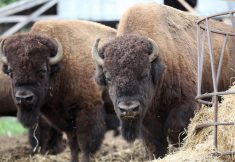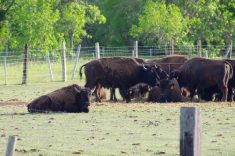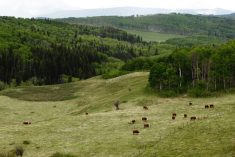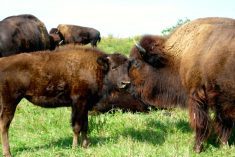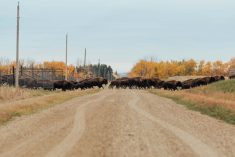Bison producer Ivan Smith doesn’t go anywhere without a butcher knife and a rifle in his truck.
“Anything can go wrong when you’re dealing with an animal that’s this athletic,” said Smith, who operates Big Bend Bison Ranch near Innisfail.
“It’s just the nature of the bison. They’re not meant to be captive, so when they are confined, it’s extremely stressful for them. Being such a powerful and athletic animal, they can damage themselves fairly easily.”
In a bison mortality study that began in 2012, trauma was the second-highest cause of death in the bison studied. That’s “obviously significant,” said researcher Pat Burrage.
Read Also

Farming Smarter receives financial boost from Alberta government for potato research
Farming Smarter near Lethbridge got a boost to its research equipment, thanks to the Alberta government’s increase in funding for research associations.
“We know that injuries and deaths associated with traumas or accidents are a problem,” said Burrage, a veterinarian from Bluffton.
“Bison, to me, are suicidal. Any time I go out to do work on bison, I’m happy at the end of the day if nothing’s broken — on bison, human, or equipment.”
On Smith’s operation, which sees about 6,000 head come through annually, this year has been “remarkably good” for injury-related bison deaths.
“I think we’ve broken one leg in the last 1,000 animals we handled,” said Smith.
“The industry has learned a lot, and it helps that they’re worth more money now. Everybody slows down and says, ‘Don’t get them running.’ That’s a $2,000 calf. Do you really want to see it hit a fence?”
That’s a big change from a decade ago, when Smith used to buy from a now-defunct auction mart.
“Within two weeks after buying at that sale, I’d lose 10 per cent of every group of animals I bought because of the way they were handled and the stress of moving from one place to another.”
Preventable deaths
In most cases, bison deaths from injury and trauma are “controllable,” said Burrage.
“If people are having issues with things getting banged up at their place, there are things we can do and strategies and management protocols we can put in place to minimize the stress and the trauma that these guys will create,” he said.
“We can’t put them in a bubble. We can’t put them in a rubber room. But we can certainly look at our setups to find out where those issues occur.”
The first step, he said, is exercising caution when putting bison into close quarters — a mistake Burrage won’t make twice.
“We figured if we baited them into an area where we had some makeshift pens put up, we could process them and preg check them the next day,” he said. “We had 250 bison cows in an area that we thought had lots of room, but the next day, we had seven dead.
“They didn’t like each other that close. Out on the pasture, they were fine, but these guys got in tight, and it was a mess.”
Secondly, don’t give bison a running start.
“We know now that we don’t give any bison — small, big, or otherwise — a 30-foot run to the chute,” said Burrage. “That’s a guarantee that we’re going to be hauling some of those out. These things will hit anything at a thousand miles an hour.”
“If there’s spots that look like if they hit they can get through, they hit it,” Smith added. “You start to recognize common denominators. When I go to other people’s farms, I can tell where the wrecks are going to be.”
Low-stress handling
But for Smith, it really comes down to “understanding the nature of the bison.”
“They’re wild by nature, and when they get stressed out, they revert back to thousands of years of survival instinct,” he said.
“Whatever you can do to handle them with less stress and less confinement, the better it is.”
Bison producers need to be “constantly looking for stress points” and figuring out how to fix them, he added.
“I used to have one gate that they would always smash their noses on. They always had bloody noses or broken horn caps because of the one gate,” he said.
“All it took was simply sheeting that one gate and changing the way it opened from one side to the other. I don’t think I’ve had an animal hit there in a year. They just don’t challenge the gate anymore because I changed the way it was.”
When bringing people on board to help out, Smith chooses helpers who “aren’t excitable.”
“About the worst thing you can have is somebody who thinks they need to yell to get a response. The quieter a person can handle them, the better.”
He also limits the number of people helping at a given time. Earlier this month, he processed 105 calves in two hours with three people helping — “an acceptable handling time” for Smith.
“All three of us knew exactly what we were doing, and we all had a job. We weren’t standing around talking, creating noise and stress. Every movement was with a purpose,” he said.
“Having one or two extra people there wouldn’t have sped up the process, but it would have created more stress in the animals. Sometimes, less is more.”
But each situation is different, Smith said, so producers who are new to the industry need to ask “the right questions” and learn how other people operate.
“Each herd of buffalo and each age group is different, so getting a producer who’s more experienced to come help if you’re new to the industry or going to other producers’ farms to see what works for them makes a big difference.”



